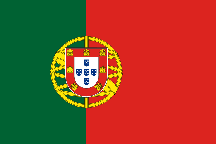|
The Portuguese Flag
The Portuguese flag represents important events in the nation's history. In the middle of the flag there is a white shield with five smaller blue shields inside it. The blue shields represent the first king of Portugal, Afonso Henriques I. Within each blue shield there are five white dots which represent the King's victory over five Moorish kings at the Battle of Ourique. Alfonso Henriques I, adopted the blue shield with five white dots as his coat of arms after he defeated the Moors and established the Christian kingdom of Portugal in 1139. The blue shields are arranged in the form of a cross to represent Christianity. The red boarder has seven castles which represent the fortifications that Alfonso Henriques I conquered from the Moors and they symbolize the extension of Portugal's territory, including the Algarve. Behind the arms there is an armillary sphere, a navigational instrument which is a reference to Prince Henry the Navigator, who initiated Portugal's maritime explorations, and to the discoveries made by Portugal during the 15th and 16th centuries. The background colors of the flag are green and red. The green represents hope and the red, which is wider than the green part, represents the blood of the portuguese that died in combat during the revolution of 1910.
|

